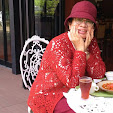After 26 years on this island, at last, I managed to cook serunding. I used to buy packets of serunding on my annual trips to Singapore but this time covid-19 prevented me. Due to restrictions on travel, it's been three years since Nov. 2018, that I've traveled.
I've gone out of serunding and this situation forced me to cook my own serunding. I googled for the simplest recipe to make sure that I've all the items.
The recipe called for lemongrass which is thriving well in a couple of styrofoam boxes, and kafir lime leaves (daun limau purut). Six years ago, I wrapped up a small limau purut plant from Singapore. I planted it and it has grown well ever since. In fact, the houseman successfully planted a couple more pots from its first batch of kaffir lime. Then, I need turmeric. Do you know that this island itself has a turmeric plantation? It's a local industry, that produces turmeric into powder. We grow our own turmeric. Every year I dry the turmeric harvest and make our own turmeric powder.
Last of all I need galangal or lengkuas. (https://images.app.goo.gl/VWDNS633rRdagWYM9). The island has its own variety of galangal or getto plants known locally. Some people swear both varieties have the same taste for cooking but I'm not convinced. I still prefer the galangal from Malaysia for my Malay food.
All set, I've all the cooking ingredients for serunding. Since the recipe claims that desiccated coconut is better for serunding, this gleefully is an advantage for me.
When I was frying, trying to reduce the moisture in the serunding, I felt dislocated temporarily. It seemed surreal with the beautiful sweet coconut fragrant coming from the kitchen and enveloping the whole house.
I use the serunding in all onigiri (rice balls), throw it lavishly on my rice as lunch on lazy afternoons.
Best of all I can eat as much serunding as I like now. Life is simple.
Haiku
Haiku
Frying serunding
memories of my grandma
memories of my grandma
picking lemongrass.




















